
Embodied carbon accounts for a huge proportion of the greenhouse gases the built environment produces. Ahead of this month’s World Environment Day, Kristina Smith asks what the industry is doing about it.
When the UK Green Building Council launched in 2007, the first event it hosted was about embodied carbon – the carbon that has gone into a material or product before a building has started its working life. “It was packed out,” remembers Richard Twinn, senior policy adviser at the council. “Since then, it seems to have gone in waves: there will be a bit of progress and then it will die down.”
Calculating and reducing embodied carbon seems to have fallen into the ‘too difficult’ category, while efforts have focused on the low-hanging fruit that is operational carbon. But today, there is a new wave of interest in embodied carbon, much of which is due to mounting pressure from board level and above.
“Investors are starting to push science-based targets,” says Twinn. “They want to know what companies are doing about embodied carbon.”
Science-based targets are about setting meaningful and measurable goals and reporting on them. Several UK built environment sector clients have already signed up to the global Science Based Targets initiative, among them the Crown Estate, Landsec, Derwent London and Barratt Developments.
Contractors might feel that they are off the hook here, because their direct impacts on embodied carbon – energy to assemble buildings and waste – are low compared to the energy needed to create materials and products in the first case. However, some contractors are going beyond that boundary to look all the way back along the supply chain
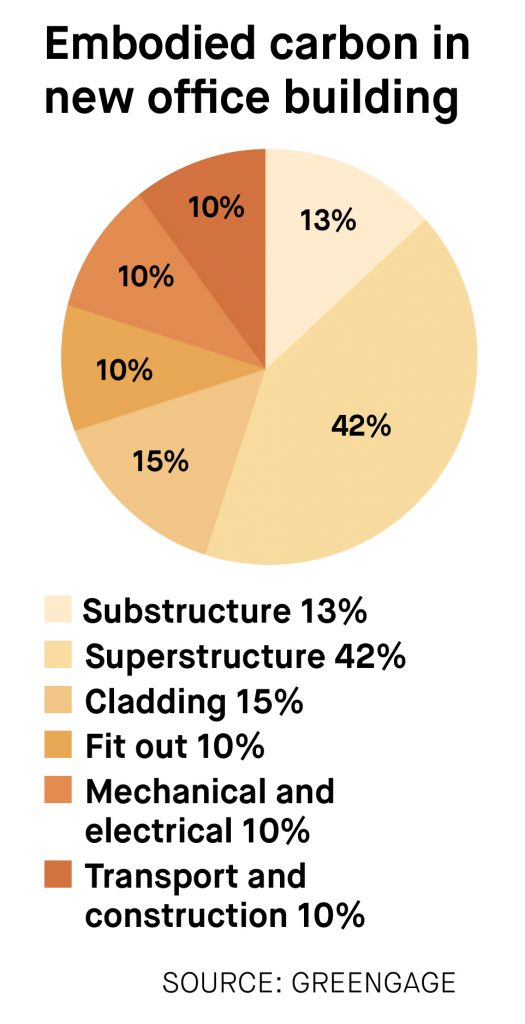
“We have been measuring our direct emissions for around 10 years and it was very clear that it was not telling the whole story,” says David Mason, senior sustainability manager for Skanska.
“It’s only when you look at the actions of all the players in the construction value chain that you look at the full picture of the impact of what you are doing. If more construction companies treated their supply chain’s emissions as their own, we would get better transparency on what it takes to build a project.”
Upfront carbon
The embodied carbon of a material is the carbon emissions associated with it throughout its life cycle, which includes impacts from any repair or maintenance work and the carbons spent dismantling or demolishing it. Upfront carbon or capital carbon is the embodied carbon spent up to the point where a building starts being used.
According the to the World Green Building Council, buildings account for 39% of energy-related global carbon emissions, with 28% coming from operational carbon and 11% from embodied carbon. Embodied carbon can account for anything between 30% and 70% of a building’s lifetime carbon. As we design buildings to be more energy efficient in operation, so the embodied carbon becomes a larger proportion of emissions (see pie charts below).
“The focus on operational carbon has driven it downwards to the point where we cannot ignore embodied carbon anymore,” says Conor Will Hayes, global structural sustainability skills lead at Arup.
Low carbon foundations
Homes provider Kiss House devised a system to reduce embodied carbon in foundations.
When Kiss House was looking for a Passivhaus-compliant foundation system for its low-carbon houses, it couldn’t find one. So, it went away and invented one.
“A large proportion of a building’s embodied carbon is in the foundations, so we wanted to find a way to drastically reduce that,” says Kiss House co-founder and director, Mike Jacob. “All the existing systems are dominated by either steel or concrete or both which are high embodied carbon materials.”
Kiss’s solution, which has a patent pending, consists of glass reinforced fibre beams and joists that sit on small steel screw-piles. An independent assessment by consultant oCo Carbon compared the Kiss foundation system to three standard ones: strip and poured slab; strip, beam and block; and piles, beam and block. It found that its carbon footprint was 70% lower than the nearest alternative (see chart below).
“This system also means that we can omit the ventilation space,” explains Jacob, “and there are no issues with degradation or thermal bridging.”
As well as using it for its own housing developments, Kiss House plans to market its GRP foundation system as an off-the-shelf solution for other housebuilders.
Jacobs believes it will be an attractive proposition to the housebuilding industry because of the growing appetite from investors for sustainable technology and products.
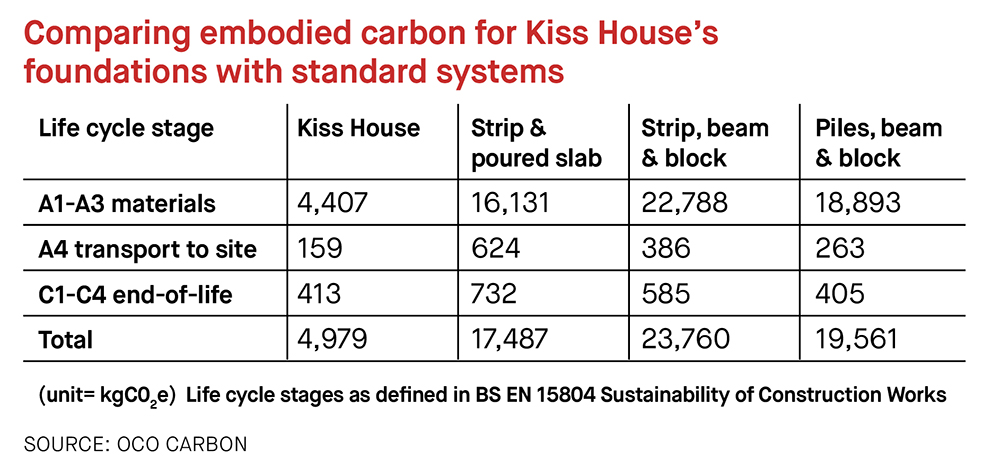
“And in the UK, the decarbonisation of the grid is reducing the carbon impact of energy, putting even more emphasis on the embodied carbon proportion.”
Methodologies and tools for calculating embodied carbon are well established now. RICS published a guide to whole life carbon assessment in 2017 and in 2018 BREEAM intro-duced credits linked to embodied carbon assessments. Commonly used tools include eTool and One Click LCA.
“Calculations for embodied carbon are easy, you just need the quantity and the rate. The challenge is managing the data and the uncertainties,” says Andrew Cripps, regional director, sustainability at Aecom.
Calculations are typically done at RIBA Stage 2, when big decisions are made, and Stage 4, when more detail is added. “It can be tricky at Stage 2 because things are changing quickly,” says Cripps.
There’s a tension between the design being far enough advanced to get a meaningful answer and making design decisions based on the embodied carbon impact. Arup, like many design firms, is developing its own tools to try and tackle this issue. “We are keen to build tools for normal engineers to use in their normal workflow,” says Mel Allwood, an associate director at Arup who leads the sustainability team in the building engineering group.
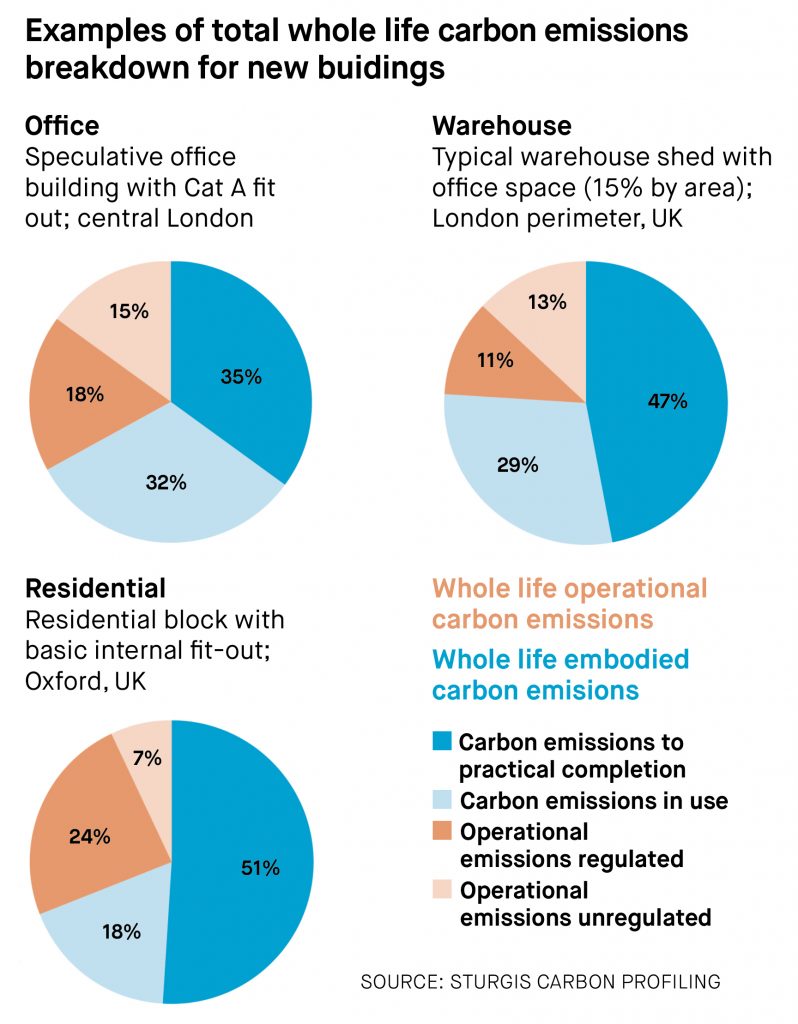
Skanska, too, is developing tools to help its engineers consider embodied energy when making decisions. “We have been improving our software tools to allow us to generate information and undertake assessments much more quickly,” says Mason. “To allow us to do our estimating, we have created a process to assess carbon. Otherwise, you have to wait until you have got the design and the material quantities before you can get the carbon footprint, so you are working behind the curve.”
So a Skanska engineer could look at reinforced concrete and see that every £1m spent would require a certain amount of concrete and rebar and this would produce a certain quantity of carbon.
The databases for these various tools are populated by generic life-cycle assessment data and, in some cases, specific data. Some manufacturers have invested in creating Environmental Product Declarations (EPDs) – indep-endently certified calculations of the lifetime impact of a product or material.
EPDs are voluntary however, which means they don’t exist for every product. And only a tiny handful of clients ask for these at the moment, says Hayes. Arup has two in Ireland, where he is based. “We would like to see embodied carbon limits included in performance specification, says Hayes. “That way, manufacturers who have invested in EPDs would be rewarded,” adds Allwood.
Do materials matter?
The big hitters, in terms of embodied carbon, are concrete and steel, which means the bulk of a building’s impact is in its foundations and frame. The manufacture of cement, which accounts for around 8% of the world’s carbon emissions, produces carbon dioxide due to the fuel needed to heat it and in the chemical reaction itself. Steel smelting is largely powered by coal.
There are no fast answers to reducing the impact of either of these emissions, says Twinn, although steel may be the easier proposition, involving a switch to hydrogen and renewable energy in future. Cement is far more challenging.

“Investors are starting to push science-based targets. They want to know what companies are doing about embodied carbon.”
Richard Twinn, UK Green Building Council
“No one has really worked out how we are going to produce cement without producing carbon,” says Twinn. “The solution seems to be carbon capture and storage, pumping it underground until we can work out what to do with it.” Research to create lower carbon cement has been underway for decades but to date there hasn’t been a viable solution for use at a large scale (see below).
Using lower carbon materials comes quite low down on the list of top ways to reduce embodied carbon. One of the best approaches is to reuse or repurpose existing buildings. “We are constructing buildings to last 60 to 120 years and, in our most expensive locations, we are knocking them down after 20 years,” says Allwood.
Buildings need to be designed with flexibility in mind, perhaps with additional capacity built into the foundations and frame. But this must be balanced against the need to avoid over engineering.
Reusing components is the next best thing, but this would call for a change of approach. ‘Design for dismantling’ has been talked about for years but is rarely executed. More design-for-manufacture could change that.
Beyond those decisions comes the opportunity to make choices about materials, looking for lower carbon options and making comparisons between suppliers, where EPDs come in.
Mason says more work is being done currently on elements where embodied carbon is more difficult to measure. “There are surprising impacts from raised floors, suspended ceilings, insulation and M&E systems,” he says.
More pressure required
While investor pressure and board level commitment will take us so far, legislative intervention will be the key to really tackling the issue of embodied carbon. The New London Plan offers some insight. The latest version, due this year, requires all referable developments (above a certain size or on green belt or open land) to provide calculations for both operational and embodied emissions.
“Central government has really not picked up on it yet,” says Twinn. “They did receive a lot of responses through the recent Part L review that talk about embodied carbon. We will have to see how quickly they will move.”
“There need to be incentives to push people to take measures, because there may be no operational or capital expenditure benefit from reducing the embodied carbon,” says Cripps.
Meanwhile, more far-sighted clients are starting to drive the pace, says Allwood: “They are much more engaged and moving fast. In some cases, where we used to be the advocates or flag bearers, we are now being challenged, which is brilliant.”
“Most of the clients we work for care,” says Mason. “The difference is maturity. You could take a mix of political pressure, investor pressure, market or societal interest and mix that in any market and get a reason for caring.”
Graphene and waste plastic paving
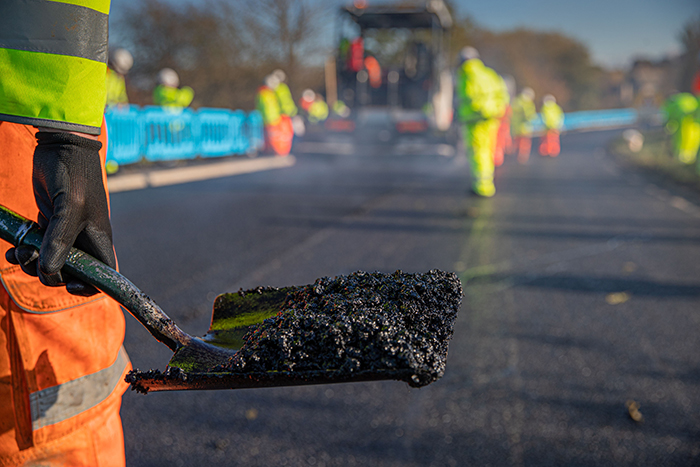
Skanska is trialling new technology from Italy that leads to longer-lasting roads and a lower carbon footprint, thanks to an additive made from graphene and waste plastic.
Gipave, developed by asphalt additive specialist Iterchimica and graphene-based product supplier Directa Plus, has been laid on a 750m-long stretch of road in the village of Curbridge in Oxfordshire.
According to Iterchimica, which has already carried out trials of the material on roads and runways in Italy, Gipave will extend a road’s life by a factor of between two and three. As well as reducing whole-life costs and disruption to road users, this also means lower carbon emissions.
Gipave, which is added in pellet form at the asphalt plant, is made of specially selected plastic waste, a compound of Iterchimica additives and G+ graphene from Directa Plus.
The plastic is sourced from waste that is usually not recycled but has to have the right chain of polymers. The graphene makes the asphalt stronger without making it more likely to crack.
Skanska is also talking to Highways England about using Gipave on a section of the M25.
Lower carbon cement
Formerly niche materials are now gaining traction in the mainstream.
Cementitious materials, such as pulverised fuel ash (PFA) or blast furnace slag, have been used in concrete mixes for years to replace a proportion of the Portland cement, say 20%.
The reason for adding them is usually practical: they can help improve the density and hence the performance of concrete and lower the heat of hydration, reducing the risk of cracking during curing. They also reduce the embodied carbon of the concrete.
Geopolymer cements, or alkali-activated cements, which substitute materials such as PFA or slag for all or most of the Portland cement, are used in concrete for specialist applications such as sewer locations which are susceptible to biocorrosion.
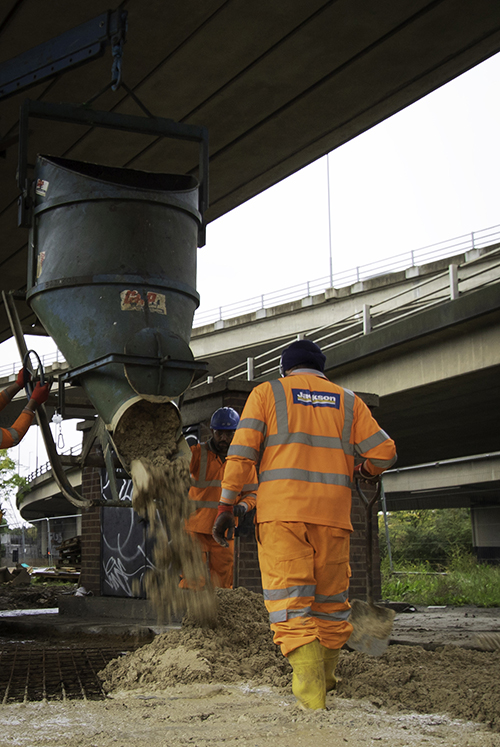
They have great potential for wider use, because they are stronger and therefore lower amount of concrete could be used in some applications. However, they have remained a niche product, too expensive for mainstream applications.
Now, major contractors and cement manufacturers are getting involved. One of the leading players in low carbon cement is France’s Hoffmann Green Cement Technologies which has developed three technologies for producing low-carbon cements, based on flashed clay and alkali-activated slag.
Last year it signed deals with Bouygues Construction and GCC to further develop concrete mixes based on two of its technologies. Hoffman Green says that its cement has one-fifth of the embodied carbon of standard cement.
Another low carbon cement product is Cemfree, which replaces Portland cement completely using 95% ground-granulated blast-furnace slag and a 5% alkali activator instead.
Aggregates firm DB Group, which produces Cemfree, says its CO2 value is 114kg per tonne, 77% lower than conventional mixes.
The product was used recently on the M25 motorway’s Woodford West Viaduct in Essex.











No doubt the Climate Emergency is the most important issue in construction today and one which is attracting many column inches, design guides, CO2 targets and consultancy offers. All of which add to what is fast becoming the world greatest game of Chinese Whispers. Few understand to any relevant level the complexity of the UK construction supply chain and its effect on embodied carbon. Much greater understanding is gained by simply have direct dialogue with the material manufacturers. Hold their feet to the fire and get the clarity and transparency of data needed to made worthwhile decisions.
A recent webinar I viewed on plastic waste pointed out that putting recycled plastic into any kind of paving/road surface was the quickest way to guarantee that it breaks down by abrasion and ends up in the ocean to poison marine life.
Good article, and comment from Neil.
As Neil says, the Climate Emergency requires us to act urgently to stop the greenhouse gases resulting from manufacturing buildings. ‘Act like our house is on fire, because it is’.
This is going to shake up how we build buildings in the same way as we are leaving coal in the ground. Now we are getting good at net zero in use buildings, almost all the greenhouse gases from modern buildings over their lifecycle are now the UpFront carbon. Great to see British Land, for example, committing to 50% reduction in embodied carbon by 2030.
As the UN says, we are in a Race to Zero. We need to get rid of the UpFront carbon in new buildings as fast as possible, or we won’t be building anything for fear of tipping the climate over.
Regulation is coming around the world, the industry has a short window of opportunity to get ready and and to deliver.
I’d be really interested to collaborate to deliver on this. Any offers? In the UK in particular COP26 next November in Glasgow will be a major milestone in this effort I suspect.
“Climate emergency” or more likely just good old hoax science.
One would think there would be way more important issues, like the nonsensical amounts of red tape to do anything in building and the over importance placed on equal opportunities, diversity and inclusion (all of which are already legislated for) instead of having a decent, cost effective product that does the job, reduces build times substantially and gives a decent profit margin for a change!
Maybe we can we stop using timber then? Trees take years to grow back and we need trees to produce oxygen. Wood also tends to burn, hardly something to be making houses and care homes from.
Glass, hmmm does that not use sand in its manufacture – sand is in short supply globally and a serious amount (around 60%) is going to one country in particular – no names no pack drill my old china!
Seems this is an expensive (for now) gimmick solution looking for a problem when there’s a need for AFFORDABLE housing.
Why does the building industry continue to give itself more problems than it can solve these days? Any time now the green brigade will be all over this and it will be yet another hurdle that is forced into legislation and needs clearing before you can move an inch.
Why not use modern methods of construction that cut down on site traffic, transport & labour – all of which funnily enough leave a carbon footprint.